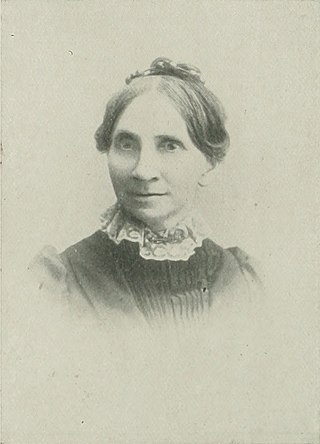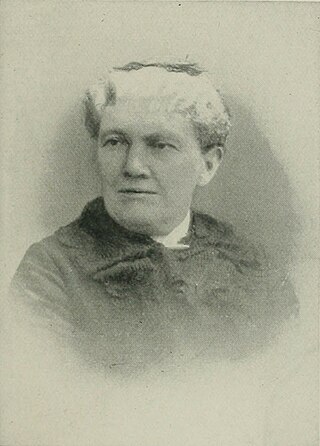
The temperance movement is a social movement promoting temperance or complete abstinence from consumption of alcoholic beverages. Participants in the movement typically criticize alcohol intoxication or promote teetotalism, and its leaders emphasize alcohol's negative effects on people's health, personalities and family lives. Typically the movement promotes alcohol education and it also demands the passage of new laws against the sale of alcohol, either regulations on the availability of alcohol, or the complete prohibition of it.
The Woman's Christian Temperance Union (WCTU) is an international temperance organization. It was among the first organizations of women devoted to social reform with a program that "linked the religious and the secular through concerted and far-reaching reform strategies based on applied Christianity." It plays an influential role in the temperance movement. Originating among women in the United States Prohibition movement, the organization supported the 18th Amendment and was also influential in social reform issues that came to prominence in the progressive era.

The Anti-Saloon League, now known as the American Council on Addiction and Alcohol Problems, is an organization of the temperance movement in the United States.
The Crusaders was an organization founded to promote the repeal of prohibition in the United States. The executive board consisted of fifty members, including Alfred Sloan, Jr., Sewell Avery, Cleveland Dodge, and Wallage Alexander. They wanted the government to create stronger laws regarding drunkenness.
The American Temperance Society (ATS), also known as the American Society for the Promotion of Temperance, was a society established on February 13, 1826, in Boston, Massachusetts. Within five years there were 2,220 local chapters in the U.S. with 170,000 members who had taken a pledge to abstain from drinking distilled beverages, though not including wine and beer; it permitted the medicinal use of alcohol as well. Within ten years, there were over 8,000 local groups and more than 1,250,000 members who had taken the pledge.

Martha McClellan Brown was an American lecturer, educator, reformer, newspaper editor, and major leader in the temperance movement in Ohio.

Eliza Daniel Stewart was an American early temperance movement leader. She sometimes referred to herself as "Mother Stewart".

Eliza Jane Trimble Thompson (1816–1905) was a temperance advocate.

Mary Greenleaf Leavitt was an educator and successful orator who became the first round-the-world missionary for the Woman's Christian Temperance Union (WCTU). Setting out on virtually non-stop worldwide tours over a decade, she "went to all continents save Antarctica," where she crusaded against alcohol and its evils including domestic violence; and advocated for women's suffrage and other equal rights such as higher education for women. In 1891 she became the honorary life president of the World's WCTU.

In the United States, the temperance movement, which sought to curb the consumption of alcohol, had a large influence on American politics and American society in the nineteenth and twentieth centuries, culminating in the prohibition of alcohol, through the Eighteenth Amendment to the United States Constitution, from 1920 to 1933. Today, there are organizations that continue to promote the cause of temperance.

The Woman's Christian Temperance Union Administration Building is a historic building in Evanston, Illinois, United States. It has served as the publishing house and national headquarters of the Woman's Christian Temperance Union since its construction in 1910. The organization had an important role in the national discussion on prohibition and women's suffrage.

Harriet Calista Clark McCabe was an American pioneer in women's work for temperance and home missions. She took a responsible position in the formation of the Woman's Christian Temperance Union (WCTU) in the period immediately following the Women's Crusade. She was the first president of the Ohio WCTU; she gave the organization its name, and drafted its Constitution. McCabe favored equal suffrage.
The temperance movement in India aims at curbing the use of alcohol in that country. In some places, the temperance movement has led to alcohol prohibition in India, with many temperance organisations continuing their work today.it led under Gandhi administration.sasipada Banerjee also a active member of this movement.
The Temperance movement began over 40 years before the Eighteenth Amendment to the United States Constitution was introduced. Across the country different groups began lobbying for temperance by arguing that alcohol was morally corrupting and hurting families economically, when men would drink their family's money away. This temperance movement paved the way for some women to join the Prohibition movement, which they often felt was necessary due to their personal experiences dealing with drunk husbands and fathers, and because it was one of the few ways for women to enter politics in the era. One of the most notable groups that pushed for Prohibition was the Woman's Christian Temperance Union. On the other end of the spectrum was the Women's Organization for National Prohibition Reform, who were instrumental in getting the 18th Amendment repealed. The latter organization argued that Prohibition was a breach of the rights of American citizens and frankly ineffective due to the prevalence of bootlegging.
The First Woman's National Temperance Convention was a founding event in the establishment of the American Woman's Christian Temperance Union (WCTU).

Abby Fisher Leavitt was an American social reformer and one of the prominent figures of the Ohio Women's Crusade. Leavitt also served as Secretary of the Baptist Women's Foreign Missionary Society of Ohio and Treasurer of the Women's Crusade Temperance Union. She was the leader of the "Praying Band", who, in the spring of 1874, daily marched down to the esplanade of Cincinnati, visiting saloons, and holding meetings inside or outside of liquor saloons, and on one occasion, was arrested and temporarily imprisoned for her temerity. She was a co-publisher of the newspaper of the National Woman's Christian Temperance Union (WCTU). In 1891, as the "Round the World Missionary of the WCTU", the World's WCTU elected Leavitt its life president.

Matilda Gilruth Carpenter (1831–1923) was a prominent member of the Woman's Christian Temperance Union, known for leading the crusade against alcohol sales in Ohio in 1874.
Non-Partisan National Women's Christian Temperance Union was an American temperance association organized at Cleveland, Ohio, January 22, 1890, as a protest against the attitude of the Woman's Christian Temperance Union (W.C.T.U.) toward political parties.
The Second Annual Meeting of the National Woman's Christian Temperance Union (N.W.C.T.U.) was held in St. Paul's Methodist Episcopal church, Cincinnati, Ohio, November 17-19, 1875.

Mary Bynon Reese was a leader in the U.S. temperance movement, serving as lecturer, organizer and evangelist for the Woman's Christian Temperance Union (W.C.T.U.) in Ohio, Washington state, and at the national level. She was also the poet laureate of Steubenville, Ohio.















